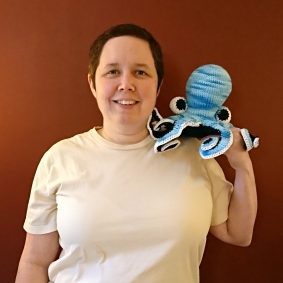Knauss legislative fellowships in Congress help build careers — and they're fun and educational. See our video and fact sheet for details.
Maureen Brooks

Maureen Brooks joined the Oceanographer of the Navy as the Interagency & International Policy Liaison. She will be working on naval oceanography policy, including issues related to oceanography, marine weather, navigation, and precise time.
Interactions between ocean physics and seaweed biology are the focus of Brooks’ Ph.D. work in the Marine Estuarine Environmental Sciences Graduate Program at the University of Maryland Center for Environmental Science. She used computer models and satellite observations to understand how Sargassum seaweed moves and grows throughout the Atlantic. Her research helps explain why so much of it has been washing up on beaches in recent years and may improve predictions that local residents depend on to prepare for these wash-up events.
As an undergraduate at McDaniel College and a master’s student at the University of Maryland, she combined her loves of science and math into computer models to understand the effects of nutrient pollution in Chesapeake Bay. Brooks was also a Blue Waters Fellow with the National Center for Supercomputing Applications, where she used high performance computing to conduct environmental research. In her free time, she enjoys kayaking, creative writing, and crafting sea creatures out of yarn.
Call for Symposium Presenters and Authors
The Chesapeake Rising: Innovative Law and Policy Solutions for Climate Adaptation in Coastal Communities symposium will explore key legal and policy considerations that affect climate adaptation strategies. It provides a unique opportunity for upper-level law students and early-career lawyers to present and publish their legal scholarship.
Program Announcements
-
-
Maryland Sea Grant has program development funds for start-up efforts, graduate student research, or strategic support for emerging areas of research. Apply here.
News and Blogs
Video Gallery
Sea Grant Film Explores a Diminishing Smithville
Smithville is a community on Maryland’s Eastern Shore, on the edge of the Blackwater National Wildlife Refuge. A century ago, Smithville had more than 100 residents. Today, it has four, in two homes: an elderly couple, and one elderly woman and her son, who cares for her.
Featured Fellow
Featured Research Project
Developing a habitat model for mysids, an important link in Chesapeake Bay food webs
Mysids are important mesozooplankton prey for many species of fish in Chesapeake Bay and are an important link in transferring energy from lower to upper trophic levels. Mysids also serve as biological vectors for benthic-pelagic coupling due to their diel vertical migration and omnivorous prey-switching behavior, which makes mysids important regulators of food web architecture. Despite their central role in coastal food webs, surprisingly little is known about mysid ecology and dynamics in Chesapeake Bay.
The Blue Crab: Callinectes Sapidus
An essential resource for researchers, students, and managers. Get your copy today!


©2025 Maryland Sea Grant. All rights reserved.
5825 University Research Court, Suite 1350 | College Park, MD 20740
Phone: (301) 405-7500 | Fax: (301) 314-5780 | Contact Us



